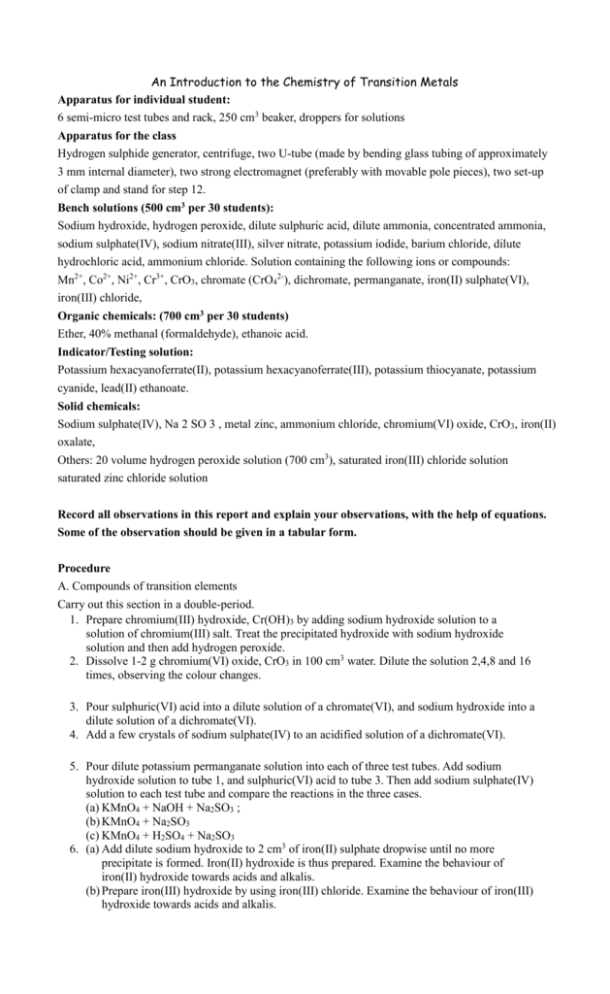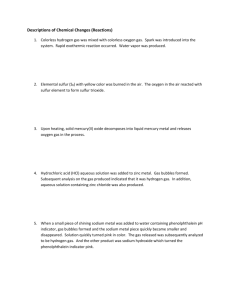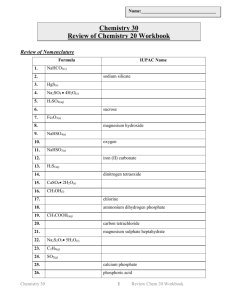T-metals-1
advertisement

An Introduction to the Chemistry of Transition Metals Apparatus for individual student: 6 semi-micro test tubes and rack, 250 cm3 beaker, droppers for solutions Apparatus for the class Hydrogen sulphide generator, centrifuge, two U-tube (made by bending glass tubing of approximately 3 mm internal diameter), two strong electromagnet (preferably with movable pole pieces), two set-up of clamp and stand for step 12. Bench solutions (500 cm3 per 30 students): Sodium hydroxide, hydrogen peroxide, dilute sulphuric acid, dilute ammonia, concentrated ammonia, sodium sulphate(IV), sodium nitrate(III), silver nitrate, potassium iodide, barium chloride, dilute hydrochloric acid, ammonium chloride. Solution containing the following ions or compounds: Mn2+, Co2+, Ni2+, Cr3+, CrO3, chromate (CrO42-), dichromate, permanganate, iron(II) sulphate(VI), iron(III) chloride, Organic chemicals: (700 cm3 per 30 students) Ether, 40% methanal (formaldehyde), ethanoic acid. Indicator/Testing solution: Potassium hexacyanoferrate(II), potassium hexacyanoferrate(III), potassium thiocyanate, potassium cyanide, lead(II) ethanoate. Solid chemicals: Sodium sulphate(IV), Na 2 SO 3 , metal zinc, ammonium chloride, chromium(VI) oxide, CrO3, iron(II) oxalate, Others: 20 volume hydrogen peroxide solution (700 cm3), saturated iron(III) chloride solution saturated zinc chloride solution Record all observations in this report and explain your observations, with the help of equations. Some of the observation should be given in a tabular form. Procedure A. Compounds of transition elements Carry out this section in a double-period. 1. Prepare chromium(III) hydroxide, Cr(OH)3 by adding sodium hydroxide solution to a solution of chromium(III) salt. Treat the precipitated hydroxide with sodium hydroxide solution and then add hydrogen peroxide. 2. Dissolve 1-2 g chromium(VI) oxide, CrO3 in 100 cm3 water. Dilute the solution 2,4,8 and 16 times, observing the colour changes. 3. Pour sulphuric(VI) acid into a dilute solution of a chromate(VI), and sodium hydroxide into a dilute solution of a dichromate(VI). 4. Add a few crystals of sodium sulphate(IV) to an acidified solution of a dichromate(VI). 5. Pour dilute potassium permanganate solution into each of three test tubes. Add sodium hydroxide solution to tube 1, and sulphuric(VI) acid to tube 3. Then add sodium sulphate(IV) solution to each test tube and compare the reactions in the three cases. (a) KMnO4 + NaOH + Na2SO3 ; (b) KMnO4 + Na2SO3 (c) KMnO4 + H2SO4 + Na2SO3 6. (a) Add dilute sodium hydroxide to 2 cm3 of iron(II) sulphate dropwise until no more precipitate is formed. Iron(II) hydroxide is thus prepared. Examine the behaviour of iron(II) hydroxide towards acids and alkalis. (b) Prepare iron(III) hydroxide by using iron(III) chloride. Examine the behaviour of iron(III) hydroxide towards acids and alkalis. 7. Effect of iron(III) compounds on the decomposition of hydrogen peroxide Place about 5 cm3 of 20 volume hydrogen peroxide solution in each of two test-tubes and add 5 cm3 of an aqueous solution of sodium hydroxide to each. To one of the tubes add 3 drops of an aqueous solution of iron(III) chloride. Compare the rates of evolution of gas in the two tubes. Repeat the test in the absence of the alkali. What iron(III) compound appears to affect the rate of decomposition of hydrogen peroxide? 8. The action of heat on iron(II) ethanedioate (oxalate) The gas evolved is a mixture. One of the gases is carbon monoxide. Heat about 2 g of iron(II) ethanedioate in a hard-glass test-tube until evolution of gas appears to cease. Allow the remaining solid to cool before tipping it onto a tile. Then repeat the above test, this time tipping out the residue while it is still hot. Compare the appearances of the two residues. Dissolve a small sample of each residue in dilute hydrochloric acid and carry out tests to establish the oxidation state of the iron compound formed. B. Study of Ions of / containing transition elements Carry out this section in another double-period. 9. Dissolve soluble salts of the following cations (1) Cr3+, (2) Mn2+, (3) Fe3+, (4) Co2+, (5) Ni2+ in water (You may obtain aqueous solutions of some or all of these ions.) and treat with:(a) sodium hydroxide solution, For Cr3+ treat the products with hydrogen peroxide solution; for Co2+ heat the suspended precipitate. (b) dilute ammonia solution (except with Cr3+ where concentrated ammonia is used.) Fe3+ and Mn2+: Excess solid ammonium chloride is added to the solution. (c) hydrogen sulphide gas. Ni2+: Dilute ammonia is added so that the solution is alkaline. Mn2+: Dilute ammonia and ammonium chloride are added so that it is alkaline. 10. Additional reactions: (a) To Fe3+(aq) solution add drops of (i) potassium hexacyanoferrate(II) solution, (ii) hexacyanoferrate(III) solution and (iii) potassium thiocyanate, separately. Keep these solutions for comparison. (b) To Fe3+(aq) add a small piece of zinc and some dilute sulphuric acid. When the reaction is complete, test the solution for iron(III) and iron(II). That is repeat step 10(a) (c) To Ni2+(aq) add carefully, drops of potassium cyanide. (d) To Co2+(aq) add sodium nitrate(III) solution and ethanoic acid followed by a potassium salt in solution. 11. To a little potassium chromate(VI)in water, treat with (a) lead(II) ethanoate solution (b) silver nitrate solution (c) dilute sulphuric(VI) acid and potassium iodide solution. (d) dilute sulphuric(VI) acid and hydrogen peroxide solution. Note the colour. Before the resulting unstable product disappears add a little ether and shake. (e) barrium chloride solution. Separate the precipitate and treat it with dilute hydrochloric acid. (f) dilute hydrochloric acid and 2 drops of 40% methanal solution. Warm. 12. The magnetic properties of the hydrated iron(III) ion and other ions. [Two set-ups on teacher's bench or side bench for the whole class.] Describe what you observe when a strong aqueous solution of iron(III) chloride contained in a U-tube is placed so that the meniscus in one arm of the U-tube is just below the centre of the ple pieces of a strong electromagnet. (If a permanent magnet is used it is easier to clamp the U-tube and move the magnet horizontally into position.). Repeat this experiment using zinc chloride instead of iron(III) chloride. End







